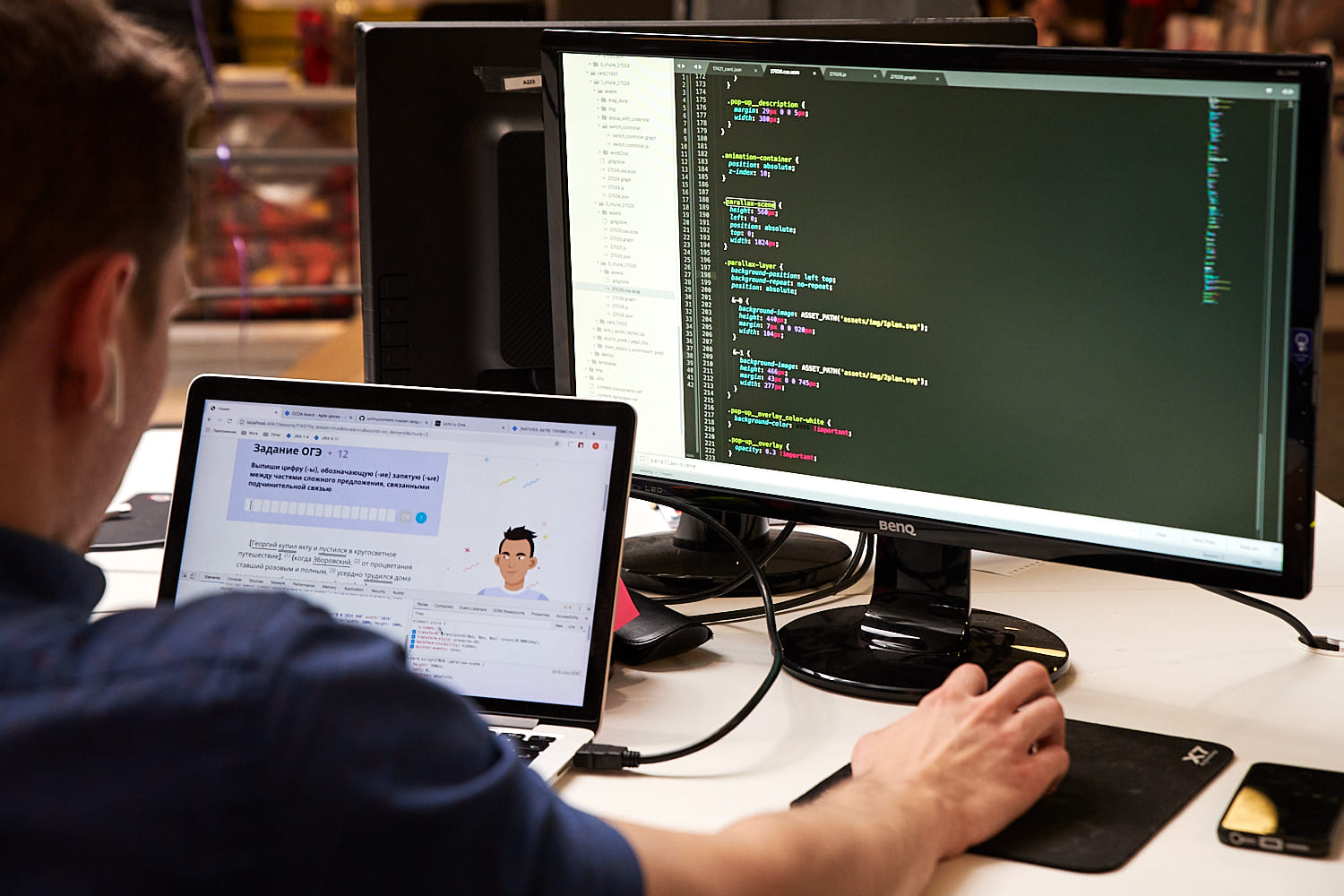Education on the Smartphone - Top 10 App Ideas for Students and Pupils
Today’s students cannot imagine studying without gadgets. Specialised websites, chatbots, learning platforms – they all help to prepare for classes, complete assignments and pass exams. Active learners are eager to try out interesting services and create their own lists of must-have learning tools. This is a ‘warm’ audience for mobile learning applications. To reach such an audience, all you need to do is offer a useful product that really makes life easier.
There is certainly a lot of competition in this area, but not all of the existing apps meet the real needs of the audience and are of high practical value. All you have to do is look at the ratings and read the reviews of different learning apps to see for yourself. But if you analyse the competition, find their weaknesses and learn from their mistakes, you can launch a cool product that will be in demand, popular and grow fast. Here are the top ideas for breaking into the educational apps market.
- Diaries, planners, notes
The app helps students organise their studies, plan their time rationally, don’t forget anything and have important information at their fingertips. The mobile tool becomes an indispensable aid in everyday work, increasing the productivity of study subjects and helping to solve current problems more quickly. Possible features:
- Notes;
- A diary with a calendar;
- A timetable for classes, consultations, events and exams;
- Learning planner, projects, tasks;
- Dictation machine;
- A reminder with audio and push notifications;
- Photo and video storage;
- Text and video chat with users to share information;
- Secure access;
- Synchronisation with other devices.
Users can create a schedule, add notes and set reminders to ensure they never miss an important event. Homework is entered into the diary, progress is tracked and step-by-step plans for major projects are created. Data is kept secure and login can be set up by fingerprint, password, numerical code or facial recognition. The app can be installed on multiple devices.

- Online tests
Testing functionality can be implemented in a number of ways:
- Test preparation (PEN, NMT). The list contains questions from previous sessions so that candidates can take the tests in a trial mode to assess their knowledge and level of preparation. The results are calculated in points, just as in a real test.
- Learning tests. Tests are used to learn specific material – foreign words, mathematical formulae, spelling rules, historical dates, etc.
- A knowledge test. The tests contain questions to test your knowledge of school subjects or subjects studied at university. You can assess how well you know the subject and whether you can be confident about your knowledge.
- Courses
The app will become a large-scale platform that brings together paid and free courses, lectures, trainings and masterclasses from various authors, schools and coaches. The app creates all the necessary functionality to access the programmes:
- Catalogue with search and filters;
- Online payment;
- Watch a video;
- Live video broadcasting and online conferencing;
- Chat rooms;
- Reminders, notifications.
The main challenge in creating an educational app is to attract quality training programmes on a partnership basis. This turns the mobile app into a large-scale distance learning service where anyone can find courses in a variety of fields. Loyalty programme tools – bonuses, discounts, free access for regular listeners, promotional offers – create additional appeal.
The user receives a diploma or certificate automatically generated in the app, which can be printed at the end of the training. By combining the quality of the educational offering with the effectiveness of the marketing strategy, it is possible to create a popular and in-demand product that will confidently hold a leading position.
- Questions, answers, advice, guidance
Textbooks, notes, Google searches, further reading – how do you find the answer to a question quickly and get good advice? Just ask other students who have faced similar problems and found a successful solution. Users of the app can ask questions and give their answers, earning bonuses and increasing their user rating.
The mobile app becomes a community of students and learners who can help each other in times of need. But there is a nuance: for the app to reach its full potential, you need to actively promote it and attract enough interested users.
- Flash cards
Memorising information using flashcards is a popular and effective method used by many students and pupils. Two types of functionality can be implemented here:
- Ready-made flashcards on different topics (e.g. foreign words, historical events, place names, definitions, formulas, rules and more). You can use the cards electronically or print them out by selecting the section you want.
- A flashcard maker for creating original learning materials. Drawing cards on paper is time consuming and inconvenient – a task that can be left to an app. Design and content can be created from scratch or from templates. Finished cards are printed. The original design, good structure and readability of the material will help you remember the material better.
The best option is to combine both functions, so that the user can not only work with ready-made maps, but also create his own variants.
- Audio Books
Pupils and students have to read a large amount of literature. To simplify the task, reading is replaced by listening to audio books. A dual functionality can be implemented in the app:
- Listen to books stored in a database. The user can quickly find a work, e.g. from a school programme, and play it back in audio format.
- A player for listening to downloaded audio books. The files are downloaded to your smartphone and the app is used as a convenient player.
The combination of the audio book database and the player gives users a wide range of options – they can search the catalogue for the material they want, or listen to their own files found in other sources.
- Formula calculator
The Formula Calculator makes it easy to do homework, coursework and practical work. The user takes a picture of a maths, chemistry or physics formula – the software reproduces a step-by-step solution to the problem. The level of difficulty can range from simple fractions and equations to a multi-function scientific calculator. The app can scan printed and handwritten text to read formulas not only from textbooks but also from notes. This reduces the amount of tedious manual work and the risk of inadvertent mistakes.
- Recognition and conversion
Students and learners are constantly working with different sources and formats of information. Situations often arise where it is necessary to quickly convert one format into another. This can be done in a mobile application:
- Scan hard copy text from paper books, essays, research papers, projects and convert to electronic format;
- Convert handwritten text to hard copy to digitise your notes;
- Convert printed text to handwriting with realistic reproduction of human handwriting;
- Detect and edit text in .pdf or .jpg files;
- Scan and automatically translate foreign text from images, photos and audio recordings;
- Online voice recognition and audio to text conversion to create a text version of the lecture;
- Convert text to audio;
- Scan pages from books and magazines with defects removed to create a high-quality image or editable file.
- Learning foreign languages
Language learning apps, one of the most sought-after areas of mobile development, should be placed in a separate category. In order for a project to be competitive and stand out from the crowd of similar platforms, it is necessary to find your “thing” and define the target audience according to their age and level of language proficiency. It is also advisable to consider the following aspects:
- Correctly structuring the curriculum, dividing lessons into topic blocks and grammar sections;
- A wide range of features – text and video lessons, vocabulary, quizzes, listening comprehension, automatic translation, interactive and game elements;
- An online chat room for user support;
- Calendar, alarms, notes;
- Check and evaluate knowledge, calculate statistics, track learning progress in a personal account.
- Multifunctional applications
All these features and more can be combined to give users more options. For example, a language learning application can be combined with a flash card builder, a text recogniser with a formula calculator – and there are many more such options. To achieve the goal and satisfy the target audience, you need to
- Clearly define the target audience segment, analyse its characteristics, create a user profile, understand its age category and educational background, and define its main work tasks;
- If the product is universal – make sure it is really suitable for most users;
- Study your competitors, assess their strengths and weaknesses, and consider common mistakes;
- Design the functional content in such a way that it is technically possible to ensure convenience and speed of use.
How to monetise a training app
Every commercial mobile product has to make a profit for its owner – that is the purpose for which it is created. An app for students is no exception. Therefore, the development should include effective ways to monetise the mobile app. This could be
- Paid access to new levels, sections and advanced features;
- In-App Purchases;
- Paid installation with free use afterwards;
- A subscription with a monthly or annual payment;
- In-App banner and video advertising;
- Payment to remove ads from the app.
At the beginning of the project, it is advisable to give users the maximum amount of free features and add paid content with subsequent updates. At all stages, the free version should be useful and interesting to the audience. A fully paid-for format is unlikely to be suitable for pupils and students, unless it is a unique and specialised product created at the request of a particular group of users.
If you have an idea for an educational mobile app, contact KitApp – we can help you develop an interesting concept and efficiently implement the technical component.

